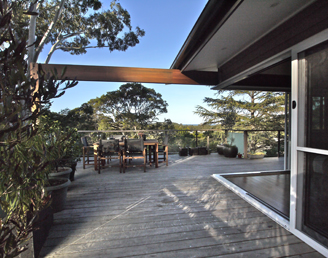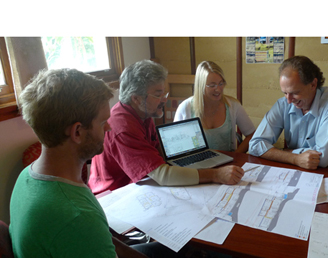New Battery Technology Update
Posted by admin on 30/10/2015 at 6:04 pm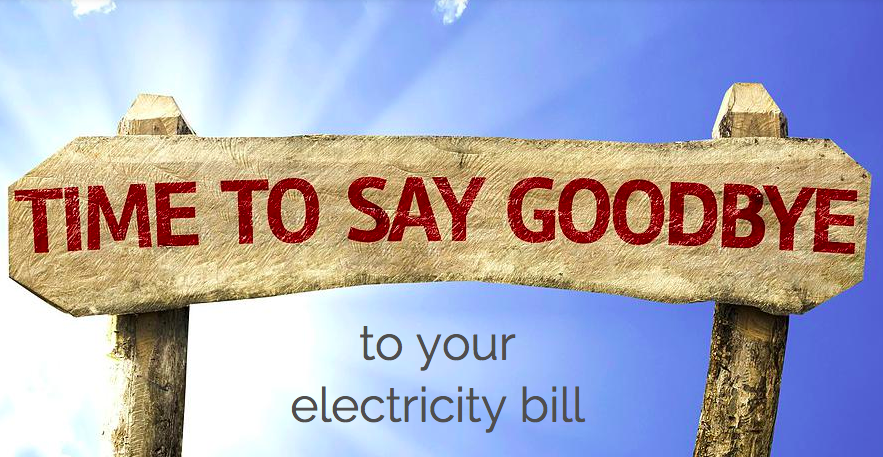
With a flurry of solar and battery technologies being released this summer it can be overwhelming trying to sort through all the information flying around out there. And with the new solar and battery systems at or below the current cost of grid power, we thought we’d get you up to speed on what’s available and what to consider before purchasing a system. We’ve invited Alex Georgiou to look at the options and give some clarity to what is both an exciting but also potentially confusing scene.
Written for Envirotecture by Alex Georgiou
New Battery Technology Update (Tesla & Others)
In this piece written especially for readers of the Envirotecture blog, I will look at:
The 3 different types of solar and battery systems
Features to consider when selecting your solution
How to size the system for your unique energy profile
The 3 Different System Types: Hybrid Ready, Hybrid Solar + Battery, and Off-Grid

The most popular systems today are the on-grid Hybrid Solar + Battery systems. With panels on the roof and batteries in the garage, these systems can cover your home’s electricity needs both day and night. They are connected to the grid in case you need a little extra power, and some can even power your home in a blackout so you never lose the food in your fridge or basic lights and entertainment.
If you want to go fully off the grid then you would have a similar system, but instead of having the grid connected you have a generator integrated with the system to kick on whenever the batteries are drained. We often recommend that customers interested in off grid systems begin with a Hybrid Solar + Battery system with an eye to switch to off grid mode down the track so the transition is seamless and you don’t have any regrettable surprises.
There are two ways to go about getting a Hybrid Solar + Battery system: Install both solar and batteries at once or hold off on the batteries with the intention of installing them down the track. The second option is called a “Hybrid Ready” system as it has all the components to integrate batteries ready to go. Go this route if you aren’t quite ready for batteries but want to lock in the government rebates of up to $7,000 for a system. (Beware: Systems advertised as “Battery Ready” systems are often just standard solar systems which would require a Hybrid inverter or something equivalent in order to integrate batteries).
Selecting the best Hybrid Solar + Battery System
Hybrid Solar + Battery systems are more complex than a standard solar array, and each comes with its own set of advantages and limitations. In the same way that a mum with four kids would have little use for a sports car, not every system is good for every situation. Here are a few questions to consider when selecting the best Hybrid Solar + Battery system for you:
Do you have single or three phase power?
Do you want to have backup power available in the event of a grid blackout?
Do you want the option of going off the grid in the future?
Do you want whole home, solar, and battery energy monitoring available online?
Do you want your battery system to be able to power all your appliances, or are you OK with it powering just the basics like a refrigerator, TV, and a few lights?
Do you want your batteries to last as long as the solar panels, or are you OK replacing them once or twice during the life of the system?
Once you know the answers to these questions we recommend that you speak with an accredited Hybrid Solar + Battery system designer who can take your answers, your home energy profile, and the available rate plans in your area to design the perfect solution for your unique situation.
How to Size Your Hybrid Solar + Battery System
Sizing your solar system properly is one of the most overlooked aspects of solar even though it’s absolutely critical to getting the results you expect when you go solar. There are three steps to sizing the system properly:
Understand your family’s energy profile
Arrange your panels to produce power when you need it
Select batteries to cover your evening and overnight usage
Below is an example of a home energy use profile (yellow line) with a Hybrid Solar + Battery system installed. The grey bell shaped curve is the solar production on a North facing roof. The tan color is power that is used straight away in the home, and the shaded area is power that is stored in the batteries for use in the evening.

- Understanding your energy profile
Your home’s energy usage patterns are as unique as you are and should be used as the basis for the overall system design.
To start with, have a look at your energy bill. On the first page you should see a “daily kWh usage” figure – that’s how much power your home uses on an average day. You’ll want to get enough solar panels to generate that amount of power each day.
For example, if you use 20 kWh per day in your home then you’ll want a system that produces 20 kWh on a daily basis. In Sydney that would be a 5kW system.
Then you need to determine how much electricity you use at night – that’s how much battery storage you’ll need.
Using the above example, let’s say that you use 4 kWh – just some lights, TV, computers, and a fridge. You’ll want to size a battery system that can store and deliver 4kWh of power.
Make sense?
Great. Those are the basics. To get more precise with your energy profile you can either make an appliance list and speak with an accredited Hybrid Solar + Battery system designer or install an energy monitoring device and track it yourself. Having an energy monitoring device installed is a simple process:

Once installed you can go around the house turning things on and off to see exactly how much energy each appliance in your home uses. We’ve done this with a few high usage clients and it really helps identify the basic power requirements vs. the optional appliances that drive up the bills.
Here is an example of a client who was only living in the house on weekends – we were able to see that his home used 25 kWh/day when he wasn’t even there and that a few outdoor heaters were spiking the bills when he was there:

This is a great way to understand your energy profile before investing in a Hybrid Solar + Battery system for your home. Once installed you can get reports for daily usage, weekly, etc. If you send that to your Hybrid Solar + Battery system designer, they can use it to design the optimal system for you.
*Note: The Hybrid Ready systems have this energy monitoring feature as well. If you are waiting for a specific battery technology to come out (like Tesla) you can install a Hybrid inverter with energy monitoring so that when the battery is released, you know exactly what size you need.
- Arrange your panels to produce power when you need it
Let’s say your house has North, East, and West facing roof options. Which is the best place to install the panels?
If you said North, you’d be exactly right if you installed the system a few years ago. Why? Because the idea was to send as much power back to the grid as possible. They used to pay you a lot for that power.
Now it’s best to send as little to the grid as possible because they don’t give you much for sending the power back. What that means is that you want to generate solar power when you use it as much as possible so you can get a smaller battery pack and still cover all your electricity needs.
Have a look at the two options for panel placement below. Which is better?
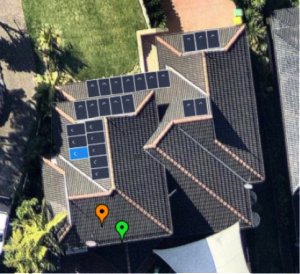
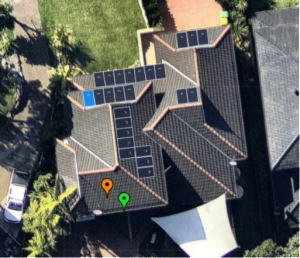
The correct answer? It depends on when you use the power.
If you use more power in the morning and during the middle of the day then the system on the right is better – the East facing panels generate power first thing in the morning, and the North facing panels produce power through 3pm.
If you use more power in the afternoon once the family comes home from work or school, then the system on the left is better – the North facing panels cover the baseline power during the day, with the West facing panels kicking in from 12pm to sunset to power the late afternoon energy usage.
Is ‘Time of Use’ for you? You may want to consider switching to a ‘Time of Use’ rate plan if that’s available in your area. ‘Time of Use’ means that you get charged more for using power in the Peak period but get a big discount on the power used during the Shoulder and Off-Peak times. This goes well with a Hybrid Solar + Battery system because in the rare case you need power from the grid, you are buying it at a huge discount.
Below is the Peak/Shoulder/Off Peak breakdown in Sydney:

*Note: this is an example from the Sydney area only. Peak, Shoulder, and Off Peak times change depending on your grid provider. Your Hybrid Solar + Battery system designer will know the relevant Time of Use rate structures in your area.
- Select batteries to cover your evening and overnight usage
There are a few key features to understand when selecting batteries for your home:
- Total Storage
Total Storage represents the total amount of electricity that a battery package can store. This is measured in kilowatt hours (kWh) which is the standard way to measure electricity. It’s also how your current electricity retailer bills you.
- Depth of Discharge
The Depth of Discharge (DoD) is how much of the Total Storage you can use in your home. The standard DoD for Lithium Ion batteries is 80%, which is much greater than traditional lead-acid batteries.
- Usable Storage
The Usable Storage is the amount of your battery’s electricity that you can use to power the appliances in your home. To calculate this, simply multiply the Total Storage kWh by the Depth of Discharge figure to get the Usable kWh amount.
Example: A 10kWh battery with 80% DoD = 8kWh of Usable Storage in your home.
- Life Span
The life span of batteries is measured in cycles. A battery cycle is when it is charged (from solar) and discharged (to your home). Your solar + battery system will typically go through one cycle per day because the battery will be charged during the day and discharged at night.
The typical number of cycles for home Lithium Ion batteries is 4000 cycles at 80% Depth of Discharge. If cycled once per day, the batteries will last over 10 years. Some of the new models are rated at 8000 cycles for a battery life of over 20 years!
- Key Feature: Flow Rate
Flow rate is how much electricity you can use from your batteries at any one time. You can think of flow rate like a hose – no matter how much water you’ve stored, the size of your hose is how much water you can use at any one time.
This is important because if you want to run multiple appliances at the same time or if you have high usage appliances (like air con or pool pumps) you need to have the adequate flow rate to do so – if not, you may not be able to use your batteries to power all of your appliances even if you have plenty of power in your batteries, and you’ll need to use power from the grid.

As you can see there are a few ways that you can be led astray by various marketing claims about how much storage you will have, how much of your bill it will eliminate, and how long the batteries will last.
They key is getting the right system for you. Have a look at the monitoring of an actual customer of ours in an average large Sydney home, below. The top green line is solar powering the home, the orange line extending to the right are the batteries powering the home, and the blue line going below zero means that power is being used from the grid:
This example shows what the monitoring looks like when, in this case, a Hybrid Solar+Battery system is designed properly. The solar feeds the home during the day and the batteries have the flow rate to handle the power use once everything is running off the batteries. There is a period in the morning (2-6am) where they are using grid power, but since they are on a Time of Use rate plan, they are getting that power for only 9 cents/kWh. If they ever want to cover their entire night usage they can simply add another battery as their system is easily upgradeable for the future.
*Note that this example is not what we might call a ‘green home’, in that it has not been designed to optimise efficiency – efficient homes should have even less grid demand, making anything spent on ‘liveability features’ an even more attractive investment.
I hope that this guide has been helpful to understand what’s available and help narrow down your search for the perfect solar and battery system. The home energy revolution is upon us, and switched on people like you are leading the charge towards a more sustainable and livable future. You now have everything you need to completely power your home with sunshine, both day and night. Enjoy your independence!
Sustainable House Design
We will help you create a family home that works well, feels good, is kind to the environment, culturally appropriate and reduces your energy and running costs.
Read MoreSustainable Commercial Buildings
We design your building to help reduce your operating costs, optimize the life cycle of your building, increase your property value and increase employee productivity.
Read MoreWorking with Envirotecture
We design beautiful, sustainable buildings that work for you, your family or your business. Full range of building design, consulting and training services.
Read More
